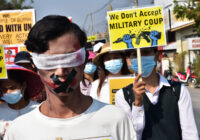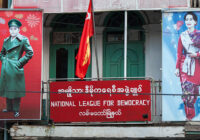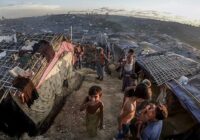Bangladesh and the UN must continue to work together to improve the conditions for nearly 1 million Rohingya refugees.
The year 2018 was a dire and desperate year for the Rohingya minority from western Myanmar. Two-thirds of the population that had been living in western Rakhine State before the end of 2017 remain displaced in crowded camps in Bangladesh. The several hundred thousand who remain in Myanmar face serious restrictions, and what the chair of an independent, international fact-finding mission describes as an “ongoing genocide.”
What will the year 2019 have in store for the Rohingya? Here are key developments to keep an eye on and some thoughts on what must be done to improve the outlook.
Rohingya Returning Home?
Repatriation of Rohingya to Myanmar is both the most necessary solution to the Rohingya crisis and the most controversial. It is not a question of whether Rohingya should be able to return to their homes; it is a question of when and under what conditions. To be clear, those conditions do not currently exist. Hundreds of homes have been destroyed. Rohingya in Myanmar continue to face restrictions and abuse. And there is little sign of accountability or a path to citizenship as demanded by Rohingya who have been forced to flee. In fact, more than 15,000 Rohingya have continued to flee conditions in Myanmar for Bangladesh in 2018.
More than 40 humanitarian organizations working on the ground in Bangladesh have warned that returning the Rohingya to their homes now would be dangerous and premature. The UN Refugee Agency (UNHCR) has been clear that current conditions in Myanmar are not conducive “to the voluntary, safe, dignified, and sustainable return of refugees.”
Still, the governments of Myanmar and Bangladesh have pushed for returns to move forward. A bilateral deal to start returns by November 15, 2018, fell apart only because Bangladesh was unable to find Rohingya willing to return voluntarily. Pressure for returns will continue through 2019, but the reality is that, more than likely, most Rohingya will not and should not return by the end of 2019. Whether returns can take place in line with international standards — that is safe, voluntary and dignified — will depend mostly on what the government of Myanmar does or does not do.
Reforms in Myanmar?
The government of Myanmar has it within its power to create the conditions conducive to safe returns of Rohingya to Myanmar. It also has a blueprint for how to do so. The Advisory Commission on Rakhine State, led by former UN Secretary General Kofi Annan, released a final report in August 2017 that was endorsed by the government of Myanmar. The report included recommendations for freedom of movement, recognition of basic rights and a path to citizenship for Rohingya in Myanmar.
By taking these steps, opening access to humanitarians and independent media and human rights monitors, and working with UNHCR, it may be possible to begin thinking about returns in 2019. But the window for doing so is quickly closing as the next election in Myanmar draws near in 2020. Aung San Suu Kyi’s National League for Democracy, already reluctant to reform and address the Rohingya crisis, will be even more so as the military’s party seeks to capitalize on anti-Rohingya sentiment. As this dynamic plays out, it will be even more important that pressure for change comes from outside — the sooner the better.
Accountability for Genocide?
The push for accountability for the crimes committed by Myanmar’s security forces against the Rohingya gained momentum in the last month of 2018. The US Holocaust Memorial Museum and the law firm that carried out a US State Department survey of the Rohingya independently concluded that there was strong evidence that crimes against humanity and genocide were committed. The State Department has not yet made a determination, but the US House of Representatives voted 394 to 1 to declare the crimes as genocide.
In August 2018, an international fact-finding mission, authorized by the UN Human Rights Council (UNHRC), concluded that Myanmar’s top military generals, including Senior General Min Aung Hlaing, must be investigated for genocide, crimes against humanity and war crimes. The UNHRC then mandated the creation of an independent mechanism to collect evidence of abuses for future prosecution. Now it is vital that this mechanism receive the funding necessary to carry out its mandate.
 The International Criminal Court has also begun an investigation into the crimes committed against the Rohingya. And international human rights groups continue to push for a mechanism for carrying out prosecutions. What forms of accountability are ultimately achieved will remain to be seen, but efforts will not go away in 2019.
The International Criminal Court has also begun an investigation into the crimes committed against the Rohingya. And international human rights groups continue to push for a mechanism for carrying out prosecutions. What forms of accountability are ultimately achieved will remain to be seen, but efforts will not go away in 2019.
It is also possible that the US State Department will be pushed to finally make a determination that crimes against humanity, if not genocide, have taken place. This would prompt further targeted sanctions. The United States has already placed sanctions on a handful of Myanmar military and border guard officials and the two army battalions that led the attacks on Rohingya civilians. But these sanctions need to extend to the highest levels, including Senior General Min Aung Hlaing.
Monsoon and Cyclones
One of the greatest fears faced by Rohingya in Bangladesh through much of 2018 was the risk of a direct cyclone hit on the Rohingya camps. The worst was avoided in 2018, but flooding and high winds destroyed shelters, injured dozens and displaced thousands. With hundreds of thousands of Rohingya remaining in fragile shelters in crowded camps, that fear will be renewed with the 2019 monsoon and cyclone seasons. Beyond a direct hit, heavy rains will threaten land slides and flooding, not to mention the risks of rapid spread of water-borne diseases.
The humanitarian community and government of Bangladesh made great efforts to move the most vulnerable Rohingya to new areas in 2018. But, as highlighted by Refugees International, coordination and preparedness were limited by restrictions on the side of the government of Bangladesh and inefficiencies on the side of UN agencies. The Bangladeshi government continues to restrict the types of materials available to build more durable shelters. It also continues to push plans to move at least 100,000 Rohingya to Bhashan Char, an island in the historic path of cyclones and prone to flooding through much of the year.
Due to government restrictions, UN agencies have also struggled with a complex, hybrid coordination structure, rather than the usual refugee response. Efforts are underway to assess the response and incorporate lessons learned for the UN response. The outcome of the recent general election in Bangladesh may create further space to address these issues. What is certain is that the 2019 monsoon and cyclone seasons will arrive and the extent to which space has opened and lessons been learned will be tested.
Another Boat Crisis?
Finally, 2019 will likely see an increase in Rohingya fleeing conditions both in Myanmar and Bangladesh by boat for other countries like Malaysia and Thailand. With increased maritime monitoring and a break up of trafficking networks, we are unlikely to see something on the scale of the May 2015 crisis, in which thousands of Rohingya and Bangladeshi refugees and migrants were abandoned at sea. But the same questions of whether countries in the region will accept any abandoned boats or push them back to sea as they did in 2015 will have to be tackled. Already several boats have taken the journey.
Beyond boats, trafficking networks will prey on women in the Rohingya camps. The longer they remain in the camps in Bangladesh, the more vulnerable they will be to such networks. This underscores the regional aspect of the Rohingya crisis. How well Myanmar’s neighbors in Southeast Asia work together to tackle trafficking and pressure Myanmar to improve conditions for Rohingya will greatly influence how the Rohingya crisis plays out in 2019.
The Rohingya will continue to face dire conditions in 2019. But there are ways that their plight can begin to be addressed. Above all, a positive path forward will depend on the ability of international actors to pressure and encourage Myanmar to create the conditions conducive to returns for the Rohingya.
In the meantime, the government of Bangladesh and UN agencies must continue to work together to improve the conditions for nearly 1 million Rohingya refugees living in the country. The year 2019 will not likely be the year that the Rohingya crisis is resolved, but with the right steps there is hope that, a year from now, we can say that the Rohingya have a better outlook for 2020.
The views expressed in this article are the author’s own and do not necessarily reflect Fair Observer’s editorial policy.
Support Fair Observer
We rely on your support for our independence, diversity and quality.
For more than 10 years, Fair Observer has been free, fair and independent. No billionaire owns us, no advertisers control us. We are a reader-supported nonprofit. Unlike many other publications, we keep our content free for readers regardless of where they live or whether they can afford to pay. We have no paywalls and no ads.
In the post-truth era of fake news, echo chambers and filter bubbles, we publish a plurality of perspectives from around the world. Anyone can publish with us, but everyone goes through a rigorous editorial process. So, you get fact-checked, well-reasoned content instead of noise.
We publish 2,500+ voices from 90+ countries. We also conduct education and training programs
on subjects ranging from digital media and journalism to writing and critical thinking. This
doesn’t come cheap. Servers, editors, trainers and web developers cost
money.
Please consider supporting us on a regular basis as a recurring donor or a
sustaining member.
Will you support FO’s journalism?
We rely on your support for our independence, diversity and quality.






